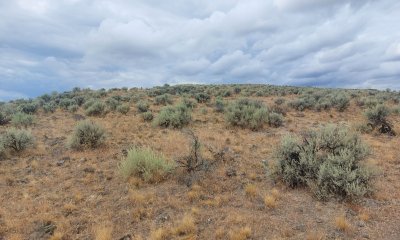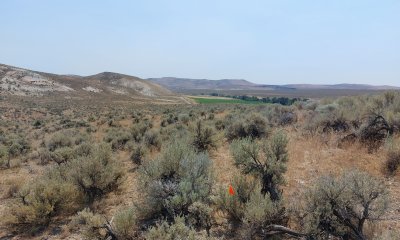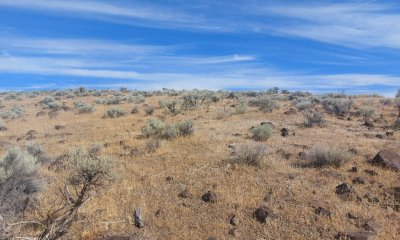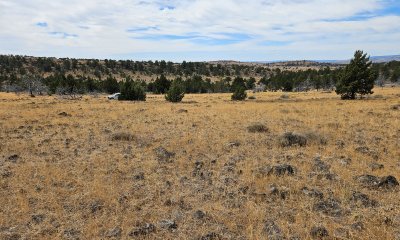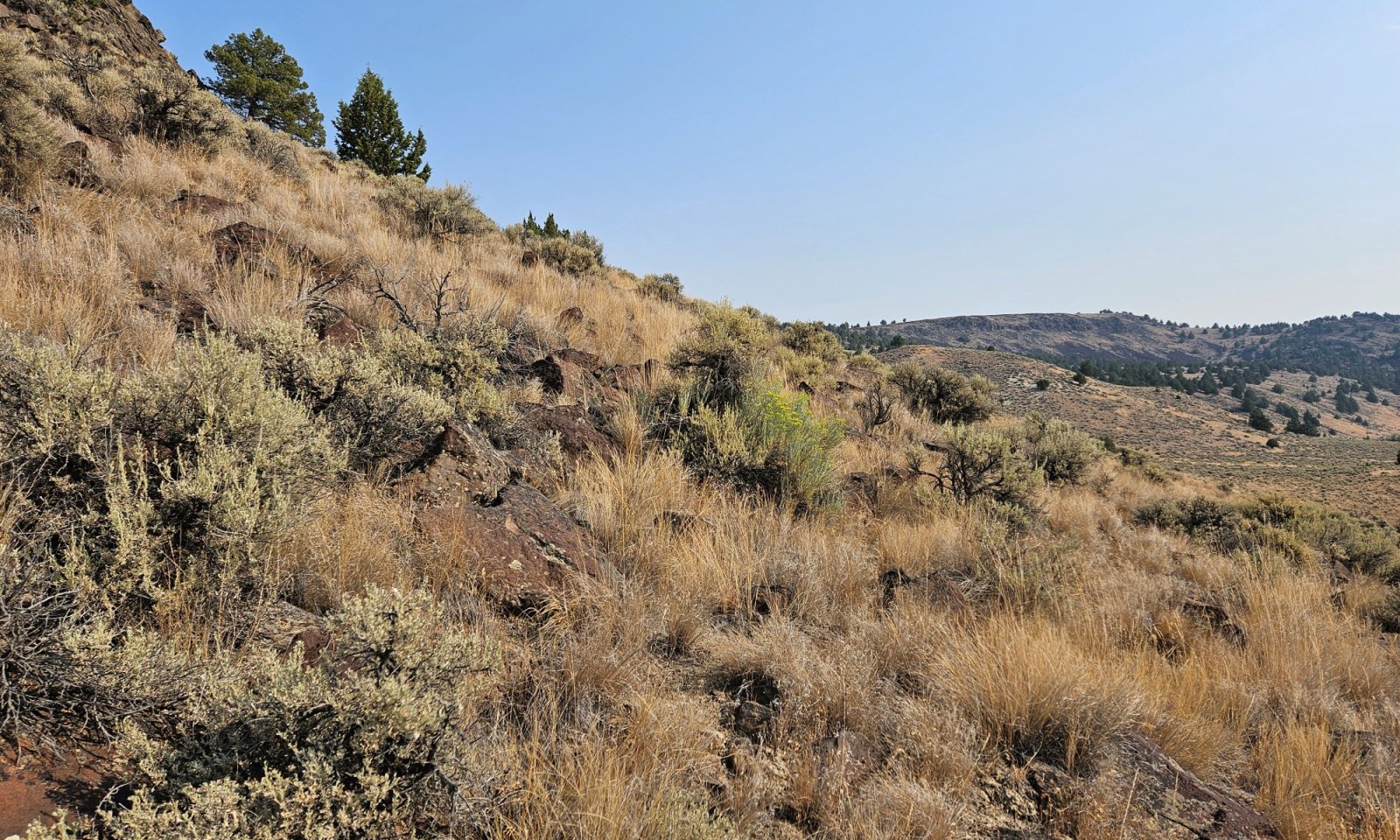
Shallow South 9-12 PZ Snake River Warm Plains
Scenario model
Current ecosystem state
Select a state
Management practices/drivers
Select a transition or restoration pathway
-
Transition T1A
Introduction of non-native species, inappropriate grazing management
More details -
Transition T2A
Inappropriate grazing management
More details -
Transition T2B
Fire, soil disruption, overutilization
More details -
Transition T2C
Time without disturbance
More details -
Restoration pathway R1A
Shrub removal, possible perennial grass reseeding
More details -
Transition T3A
Catastrophic fire, soil disturbing treatment, inappropriate grazing management
More details -
Transition T3B
Time without disturbance
More details -
Restoration pathway R4A
Annual grass treatment, reseeding
More details -
Restoration pathway R5A
Tree thinning, reseeding
More details -
Restoration pathway R5B
Tree thinning, failed seeding
More details -
Restoration pathway R5C
Catastrophic fire
More details -
No transition or restoration pathway between the selected states has been described
Target ecosystem state
Select a state
Description
The Reference state is representative of the natural range of variability in pristine conditions (Stringham et al., 2019). This state has no introduced plant species. Disturbance patterns reflect historic return cycles or increased return has not reduced the site's resistance and resilience to disturbance. The Reference state has two communities: a grass shrub community and a perennial grass community. Community dynamics are controlled primarily by fire and time. All functional groups are present, and a diverse forb component exists although it is not the dominant component. At the time of this writing, one site was considered to be in the Reference state so the bulk of community information is inferred from current potential sites and historical data.
Characteristics and indicators
•No introduced plant species
•All functional groups present
•High plant vigor and reproductive capacity
Resilience management
Reference sites should be prioritized for protection whenever possible. Management should focus on conservation and protection above other uses. Surrounding landscapes should be managed to reduce non-native species introductions and other impacts (Maestas et al., 2022).
Submodel
Description
This state is similar to the Reference state but some amount of nonnative species occur and species composition has been somewhat altered. Ecological functions often remain intact but due to the presence of these non-native species, resistance and resilience to disturbance have been reduced (Stringham et al., 2016). This state has three communities: a grass-shrub community, a shrub-grass community, and a perennial grass community. The latter two represent two different at-risk communities; at risk of converting to the Shrubland state and at risk of converting to the Annual state, respectively.
Characteristics and indicators
•Low cover of introduced plant species (commonly less than fifteen percent total)
•Deep-rooted perennial grass cover at or above twenty percent
•All functional groups present with no significant decrease in reproductive capability
Resilience management
Sites in the current potential state should be prioritized for protection wherever possible, especially when in good quality condition (Maestas et al., 2022). Management activities should focus on limited seed sources of invasive annual grasses and promote perennial plant vigor and reproduction.
Submodel
Description
This state is dominated by shrubs and shallow-rooted perennial grasses and is a result of overgrazing especially during key growth periods of cool-season bunchgrasses. Deep-rooted perennial grasses have been reduced or completely excluded, rarely exceeding five percent foliar cover. This state consists of one community, the Shrubs and Shallow-rooted Grass community (Hanna and Fulgham, 2015). Although highly variable, invasive annual grass cover is often higher than in the current potential state. Without deep-rooted perennial grasses, this state is more prone to erosion than the Current Potential state.
Characteristics and indicators
•Typically, less than five percent foliar cover of deep-rooted perennial grasses.
•High cover of shallow-rooted perennial grass
•Increased invasive annual grass but not enough to become a dominant component.
Resilience management
Management actions should focus on reintroduction of deep-rooted perennial grasses. Invasive annual grass control may also be a priority to avoid transitioning to an annual state.
Submodel
Description
This state is dominated by invasive annual grasses. These grasses increase litter amounts which inhibit deep-rooted perennial grass recruitment and increase fire frequency. These two effects create a positive feedback loop that increases invasive annual grass populations (Reisner et al., 2013).
Characteristics and indicators
•Annual grass foliar cover greater than 25 percent
•Sagebrush cover is variable but even when common, interspaces dominated by invasive annual grasses.
•Herbaceous litter cover can be higher than other states
Resilience management
Any management actions should focus on reducing the annual grass cover and limiting its spread to other areas (Smith et al., 2022).
Submodel
Description
This state is characterized by the co-dominance or dominance of young junipers at the site. Sagebrush and deep-rooted perennial grasses may be present but no longer control site resources and are likely declining. Bare ground is expected to increase and on sites with higher slopes erosion may become a significant issue.
Characteristics and indicators
• Western juniper canopy cover above ten percent
• Bare ground increasing possibly showing signs of soil erosion such as grass pedestals
• Shrubs showing signs of decreasing
Resilience management
Management should focus on young juniper removal and either preservation or reintroduction of deep-rooted perennial grasses. Before treatment, sites should be examined closely as success or failure depends on many factors (Miller et al. 2005). See state transition pathways for more details.
Submodel
Mechanism
Introduction of non-native species. Over-utilization grazing could also aid in susceptibility of the site to invasion.
Context dependence
Circumstances that increase bare soil such as drought or soil-disturbing activities, may increase opportunities for non-native species to invade.
Mechanism
Repeated overgrazing reduces deep-rooted perennial grasses and shifts to shrubs and shallow-rooted grass dominance. This shift increases bare soil and the possibility of soil erosion.
Context dependence
Soil vulnerability to compaction will be highest in spring when the soil is saturated and unfrozen.
Mechanism
High-intensity or frequent fire that removes the sagebrush component from the site. Soil-disturbing treatments or repeated overutilization may also cause this transition.
Context dependence
Transition rate will depend on multiple factors including existing plant cover, biological soil crust integrity, seed bank integrity, and recent weather patterns.
Mechanism
Time without fire allows for maturation and spread of the juniper community.
Context dependence
The speed of encroachment depends on the distance to a seed source and available moisture.
Mechanism
Mowing shrubs may allow for perennial grasses to become more dominant.
Context dependence
Actions to remove Wyoming big sagebrush increase the risk of invasive annual grasses becoming prevalent. Recovery may depend on the existing plant understory and the ability to control annual grasses while recovery takes place.
Mechanism
High-intensity or frequent fire. Sagebrush removal activities that disturb the soil.
Context dependence
Transition rate will depend on existing cover and seedbank integrity.
Mechanism
Time without fire allows for the maturation and spread of juniper communities.
Context dependence
Speed of encroachment depends on the distance to a seed source and available moisture.
Mechanism
Targeted shrub planting and fire breaks may keep fire out of the site long enough for shrubs to recover.
Context dependence
Herbicide application can help control invasive annual grass populations to support shrub growth.
Mechanism
Tree thinning coupled with a successful seeding of missing functional groups. Invasive annual grass dominance is common following fire so fire as a tree thinning tool should only be used where invasive annual grasses remain in trace amounts.
Context dependence
The success of tree thinning likely relies on pre-treatment plant communities. In sites where all functional groups are still present, tree thinning can result in a restoration to the Current Potential state. The loss of deep-rooted perennials in the pre-treatment community may result in a transition to the Shrubland state. A pre-treatment community dominated by invasive annual grasses will likely result in a transition to the Annual state.
Mechanism
Ground disturbing mechanical tree thinning coupled with failed or no seed applied restoration attempt. Invasive annual grass dominance is common following fire so fire as a tree thinning tool should only be used where invasive annual grasses remain in trace amounts.
Context dependence
The success of tree thinning likely relies on pre-treatment plant communities. In sites where all functional groups are still present, tree thinning can result in a restoration to the Current Potential state. The loss of deep-rooted perennials in the pre-treatment community may result in a transition to the Shrubland state. A pre-treatment community dominated by invasive annual grasses will likely result in a transition to the Annual state.
Mechanism
Catastrophic fire or ground disturbing mechanical treatment.
Context dependence
The success of tree thinning likely relies on pre-treatment plant communities. In sites where all functional groups are still present, tree thinning can result in a restoration to the Current Potential state. The loss of deep-rooted perennials in the pre-treatment community may result in a transition to the Shrubland state. A pre-treatment community dominated by invasive annual grasses will likely result in a transition to the Annual state.
Model keys
Briefcase
Add ecological sites and Major Land Resource Areas to your briefcase by clicking on the briefcase (![]() ) icon wherever it occurs. Drag and drop items to reorder. Cookies are used to store briefcase items between browsing sessions. Because of this, the number of items that can be added to your briefcase is limited, and briefcase items added on one device and browser cannot be accessed from another device or browser. Users who do not wish to place cookies on their devices should not use the briefcase tool. Briefcase cookies serve no other purpose than described here and are deleted whenever browsing history is cleared.
) icon wherever it occurs. Drag and drop items to reorder. Cookies are used to store briefcase items between browsing sessions. Because of this, the number of items that can be added to your briefcase is limited, and briefcase items added on one device and browser cannot be accessed from another device or browser. Users who do not wish to place cookies on their devices should not use the briefcase tool. Briefcase cookies serve no other purpose than described here and are deleted whenever browsing history is cleared.
Ecological sites
Major Land Resource Areas
The Ecosystem Dynamics Interpretive Tool is an information system framework developed by the USDA-ARS Jornada Experimental Range, USDA Natural Resources Conservation Service, and New Mexico State University.

